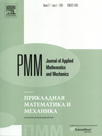 | | Journal of Applied
Mathematics and Mechanics
Russian Academy of Sciences | | Founded
in January 1936
(Translated from 1958)
Issued 6 times a year
ISSN 0021-8928
(print version) |
Archive of Issues
| Total articles in the database: | | 10482 |
| In Russian (ΟΜΜ): | | 9683
|
| In English (J. Appl. Math. Mech.): | | 799 |
|
| << Previous article | Volume 77, Issue 1 / 2013 | Next article >> |
| V.P. Radchenko and M.N. Saushkin, "A phenomenological method of calculating the residual stresses and plastic deformations in a hollow surface-hardened cylindrical sample," J. Appl. Math. Mech. 77 (1), 102-108 (2013) |
| Year |
2013 |
Volume |
77 |
Issue |
1 |
Pages |
102-108 |
| Title |
A phenomenological method of calculating the residual stresses and plastic deformations in a hollow surface-hardened cylindrical sample |
| Author(s) |
V.P. Radchenko (Samara, Russia, radch@samgtu.ru)
M.N. Saushkin (Samara, Russia) |
| Abstract |
A phenomenological method is proposed for calculating the residual stress and plastic deformation fields in a hollow surface-hardened cylindrical sample. Versions of the hardening are considered that lead to isotropy and anisotropy in the plastic deformations in the surface layer. A hardening anisotropy parameter is introduced that relates the axial and circumferential components of the residual plastic deformation tensor. The experimentally determined axial and/or circumferential components of the residual plastic stress tensor are used as the initial information. The tensor fields of the residual stresses and deformations are constructed assuming the hypothesis of surface hardening anisotropy and the absence of secondary plastic compression deformations and that the tangential components of the residual stress tensor and the plastic incompressibility of the material are small. A technique is developed for identifying the parameters of the proposed method. The adequacy is checked using experimental data for test pieces of type 45 and 12X18H10T steels hardened by hydro-shot blasting treatment and of type 45 steel hardened by treatment with a roller. Good agreement is observed between the calculated and experimental results. It is noted that the anisotropic hardening procedure leads to a substantial difference between the circumferential and axial components of the residual stresses in the hardened layer, unlike the case of isotropic hardening where they are practically identical. |
| Received |
22 November 2010 |
| Link to Fulltext |
|
| << Previous article | Volume 77, Issue 1 / 2013 | Next article >> |
|
 If you find a misprint on a webpage, please help us correct it promptly - just highlight and press Ctrl+Enter If you find a misprint on a webpage, please help us correct it promptly - just highlight and press Ctrl+Enter
|
|

 Russian
Russian  English
English